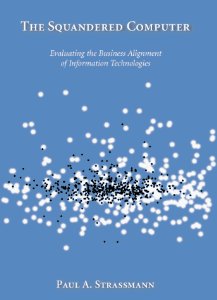
Paul Strassmann
5.0 out of 5 stars Deserves careful study–a powerful message about technology March 4, 1999
By Lou Agosta (lagosta@21stcentury.net)
The main targets for Paul Strassmann's unmasking of misconceptions about the business use of computers include the Gartner Group, advocates of Best Practices, and that mouth piece of computing vendors, the computing trade press (e.g., CIO Magazine). While not a particularly angry polemic, Strassmann is all the more devastating for his understated, simple, and straight-forward marshaling of basic facts.
The Gartner group is making a fortune telling executives in various industries what per cent of revenue for a particular vertical industry should be spent on their firms computing function in order to remain profitable. For example, insurance spends a relatively high per cent of revenue, whereas manufacturing is less. Retail is in the middle. In industry after industry, Strassmann demonstrates there is no correlation in spending on computers and profitability. None.
That is the meaning of the random scatter diagram which graces the front cover of this book. Some profitable companies spend a large per cent, others spend a significantly smaller per cent. Some losing firms spend a large per cent, others spend a smaller one. This is regardless of what measure of profitability is used (return on assets, return on net investments, or economic value-added (Strassmann's favorite)). Note this result, while surprising, is consistent with computers making decisive contributions to efficiency, competitive viability, and value creation.
One of Strassmann's databases collects facts that warrant a sobering conclusion. Over half the nominees of popular magazine excellence awards are likely to be losers in economic value within three years of scoring well on somebody's checklist of best practices (p. 137). Strassmann unmasks CIO Magazine's “Enterprise Value Awards” as attributing to computerization gains made by improving basic business and management practices. When the single most profitable industry recorded a return on equity of about 35 % (1996), what are claims of 14,000% and 600% supposed to mean? Such astronomical claims are a disservice to information systems managers and to the computer industry as event subsequently demonstrated at the selected companies (pp. 170-171).
The trade press rely on survey data about IT spending gathered by main-in questionnaires or telephone surveys (p. 107). Is that what you want to rely on? Instead of INFORMATION WEEK “Excellence Awards” a better method would be to interview customers who have defected to the competition. Instead of treating computers as a capital asset, rather evaluate what effective management can accomplish with the cooperation of knowledge workers equipped with computers. Naturally, this puts responsibility squarely where it belongs. One particularly Strassmannesque idea is that software is (or ought to be) the repository of knowledge capital about a business and its processes. If well-designed — a large IF — software is virtually immortal,can be continually improved as bugs are corrected, is cheap to reproduce, and does not wear out in being used. The residual value of software — what it is worth to an organization at the end of the estimated payback period used to justify its being built in the first place — is not generally recognized in justifying undertaking software projects. It needs to be.
Its recognition would invite and justify the use of object-oriented methods and open system standards on a large-scale and work against the build-and-junk approach (p. 281) so greatly promoted by the vendors and trade press benefiting from the churn in infrastructure. Systems become obsolete as operators and users are unable to adapt user interfaces to changing business processes and market conditions requiring rapid-response actions under stressful conditions. Residual value is enhanced by familiar information manipulation methods across applications.
It is to this simplifying factor that Strassmann attributes the run-away success of internet browsers and the relevant (anti-Microsoft Windows) paradigm. “Instinctive simplicity carries enormous benefits” (p. 333). The recommendation? “Adopt tools that keep long-term knowledge assets and short-term technological assets separated” (p. 355). At times Strassmann may seem like a veritable voice crying in the information wilderness. However,given his credentials as a former CIO at Xerox and Undersecretary (i.e., CIO) of Information Technology for the United States Department of Defense, his simple and powerful style of writing from significant unrecognized knowledge, it is this reviewer's belief he will provide tomorrow's management gospel. One can only hope people really read him this time. –Excerpt from my review published in COMPUTING REVIEWS, December 1997.




